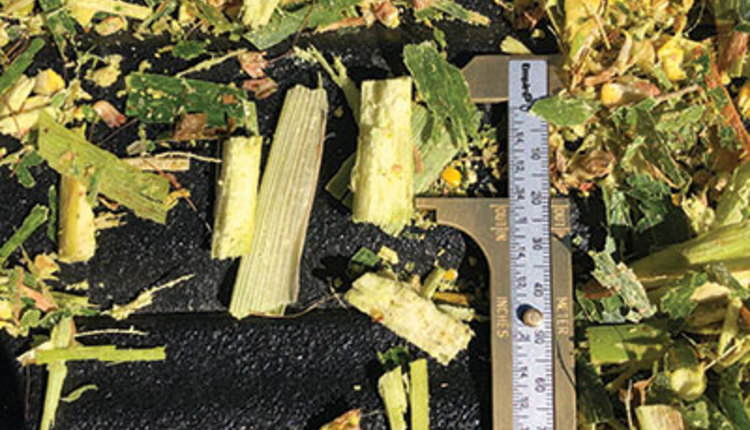
I walked into a Northern Tool and Equipment store last year, which is somewhat of an unusual event. I’m not mechanically inclined, and my wife is always surprised when I can fix our dishwasher or change the car battery. I walked out with a caliper, not the fancy digital one, just a basic sliding metal caliper. Google tells me that they’ve been used for thousands of years, but it’s taken me 50 years to discover I need one.
As forage season gets rolling, there is always a discussion about particle size — factors such as knife settings, rollers, and theoretical length of cut. Inevitably, someone grabs a handful of some haylage or corn silage and the conversation goes something like this:
“How’s it look?”
“Seems about right.”
A few years ago, when photo images came back from Mars, everyone was amazed at the scenery with impressive boulders all around . . . at least until we were told these weren’t boulders but rather just small rocks on the sand. Perspective is difficult in photos unless you have a reference point. Four hundred-foot wind turbines don’t look that big until you see them next to a 90-foot silo.
Offering perspective
Communication within a forage team is important, but how do we communicate? Texting has made the transfer of pictures easy. The person in the chopper or pack tractor can easily send pictures to the crew of a handful of silage, but does the person have the hands of the wrestling legend Andre the Giant or the basketball phenom Spud Webb?
When we use a simple reference point that everyone can see, such as the caliper, we can begin to communicate more effectively. Are the leaves coming out of the chopper at 19 or 24 millimeters (mm)? The difference (5 mm) doesn’t seem like much, but for our high-producing cattle, it can be the difference between having enough effective fiber or not. Put another way . . . it’s the difference between buying and adding one-half pound of straw to the ration to keep the cows healthy, or not. Go out and measure some particle sizes. Are you sure you could visually tell the difference between 19 and 24mm?
For the nutritionist or agronomist, we need a simple and effective method during the push of the forage harvest to communicate. There are some that might advocate the use of a Penn State Particle Separator (PSPS). Different sizes of sieves allow us to see the length of the forage. This works okay, but it has its limitations. First, the chopper operator doesn’t have a PSPS to monitor progress across a week of chopping. Second, and especially for corn silage, the results can be misleading.
From year-to-year, corn silage can range from 25% to 40% starch. Depending on moisture and processing, much of this starch may end up on the bottom pan of the PSPS. When we have a corn silage that is high in starch (40%), the bottom pan (and 4 mm screen) will be heavier. The “average” chop will seem to be smaller because of the grain, but in reality the leaves and stalks haven’t changed in length at all. When you look at the forage with a caliper, you will see the average length of leaves might be in the ideal range regardless of what the PSPS indicates.
So why not just use a standard ruler?
A ruler might work, but I’m not sure that I want a 12-inch ruler in my pocket. The small plastic ones would likely snap every time I leaned over to tie my shoes. The thing I like about the caliper is the ability to put the forage between the jaws. It eliminates any optical illusion in pictures and doesn’t leave room for errors.
What’s the ideal?
The desired particle length should always be part of the forage team’s discussion before harvest begins. For corn silage, 19 to 21 mm on non-brown midrib (BMR) corn silage and 21 to 24 mm on BMR corn silage seems to work for many dairies. For haylage, it likely depends on whether it’s alfalfa, grass, or a cereal grain. The maturity of the crop also comes into play. Cereal grains are likely going to be chopped finer than haylage to ensure adequate packing. A mature sorghum-sudangrass crop is going to be chopped finer than a less mature one.
A caliper can also help when evaluating hay. It’s easy to tell the difference between a thick-stemmed, 120 relative forage quality (RFQ) hay and a bale that’s 220 RFQ, but what about two hay samples closer to the middle? Again, think of Mars. Of course, the lab analysis is likely the starting point, but if you are marketing hay, a simple, quick picture with a caliper might more effectively communicate to the end user.
They say a picture is worth a thousand words. Adding a caliper to your photo may just offer some additional text and perspective.
This article appeared in the April/May 2021 issue of Hay & Forage Grower on page 18
Not a subscriber? Click to get the print magazine.

